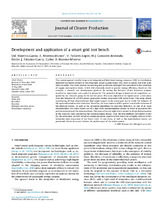Mostrar el registro sencillo del ítem
Development and application of a smart grid test bench
| dc.contributor.author | Moreno-García, Isabel | |
| dc.contributor.author | Moreno-Muñoz, A. | |
| dc.contributor.author | Pallarés López, Víctor | |
| dc.contributor.author | González Redondo, Miguel Jesús | |
| dc.contributor.author | Palacios García, Emilio | |
| dc.contributor.author | Moreno Moreno, Carlos Diego | |
| dc.date.accessioned | 2024-02-05T13:04:33Z | |
| dc.date.available | 2024-02-05T13:04:33Z | |
| dc.date.issued | 2017 | |
| dc.identifier.issn | 1879-1786 | |
| dc.identifier.uri | http://hdl.handle.net/10396/27118 | |
| dc.description.abstract | The current upward trend in large-scale integration of distributed energy resources (DER) in distribution networks has fueled interest in knowing their power quality issues (PQ), even in nearly real-time scale when possible. This trend involves researching new protection strategies that contribute to the reduction of supply interruptions times, which will ultimately result in greater energy efficiency. Based on this scenario, a research and development platform for testing the behavior of the electronic systems involved in supervision and control is presented. The proposed design is based on the experience acquired by our research group in the last ten years. The main objective is to reproduce on a laboratory scale the behavior of a 9 kVA power generation system associated with active loads. This setup allows reproducing all kind of perturbation that might happen in the actual grid and to verify the behavior of the system devoted to their detection. Therefore, the main interest of this system is to test the behavior of the physical devices, as well as the advanced algorithms for real-time detection. As one of its main characteristics, the setup makes use of a high-level synchronization system in order to guarantee the precise estimation of the response times. The most advanced objective is related to the global estimation of the response time considering the communication delays. Thus, the test platform contributes to the PQ, the protection, and the advanced communications, aspects which stand out as highly relevant in the imminent wide expansion of the Smart Grids. A case study, as well as the experimental results, are presented, which show and address the performance of the entire system. | es_ES |
| dc.format.mimetype | application/pdf | es_ES |
| dc.language.iso | eng | es_ES |
| dc.publisher | Elsevier | es_ES |
| dc.rights | https://creativecommons.org/licenses/by-nc-nd/4.0/ | es_ES |
| dc.source | Journal of Cleaner Production, Vol 162, Pages 45-60 (2017) | es_ES |
| dc.subject | Smart grid | es_ES |
| dc.subject | IEC 61850 | es_ES |
| dc.subject | Real-time | es_ES |
| dc.subject | Intelligent electronic device | es_ES |
| dc.subject | Performance evaluation | es_ES |
| dc.title | Development and application of a smart grid test bench | es_ES |
| dc.type | info:eu-repo/semantics/article | es_ES |
| dc.relation.publisherversion | https://doi.org/10.1016/j.jclepro.2017.06.001 | es_ES |
| dc.relation.projectID | Gobierno de España. TEC2013-47316-C3-1-P | es_ES |
| dc.rights.accessRights | info:eu-repo/semantics/openAccess | es_ES |

